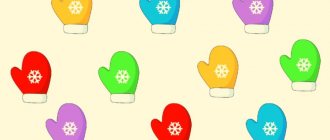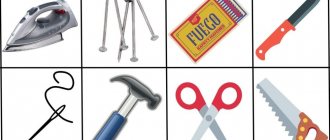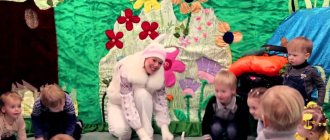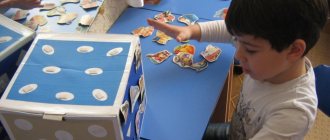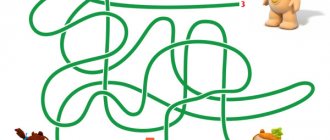Goals of didactic games in kindergarten
Didactic games contribute to the comprehensive development of a preschool child.
Their goals:
- formation of ideas about objects and phenomena of the surrounding world;
- consolidation of knowledge about flowers;
- familiarity with geometric objects;
- formation of ideas about right and wrong actions and actions;
- nurturing positive personal qualities, the ability to interact with others;
- familiarization with counting and numerical characteristics;
- development of memory, speech skills, concentration, ability to think logically;
- emotional and creative improvement, development of imagination;
- improvement of fine motor skills, general coordination and motor response;
- development of respiratory ability.
Consultation for teachers “Printed board games, their role in the mental development of children”
Galina Batyreva
Consultation for teachers “Printed board games, their role in the mental development of children”
“A game is a huge bright window through which a life-giving stream of ideas about the world around us flows into the child’s spiritual world.”
V. A. Sukhomlinsky
“Game is the spark that ignites the flame of inquisitiveness and curiosity”
V. A. Sukhomlinsky
“Play is the way for children to understand the world in which they live and which they are called upon to change.”
A. M. Gorky
What types of board games ? The modern world is quite rich in all kinds of games; board games are a separate whole huge world for children .
The content of board games is very diverse. This includes: inserts, puzzles, cubes, pyramids, mosaics, various lacing, construction sets , lotto, dominoes. Some types of lotto and paired pictures introduce children to individual objects (dishes, furniture, animals, birds, vegetables, fruits, and introduce them to their qualities and properties. Others clarify ideas about seasonal natural phenomena (seasons, various professions (Game “ What to Whom” need to?"
).
A large selection of board and printed games on a wide variety of topics: classification, generalization, comparison, counting, composing problems, associations. A huge variety of games for the development of speech in preschoolers - accumulation of vocabulary, development of phonemic processes, lexico-grammatical representations, coherent speech of children , development of cognitive interests of children , teaching foreign languages, etc. Therefore, we can say that an infinite number of games have already been created children board games for their harmonious development .
The main thing and very important is for adults not to get lost in all this diversity, and to highlight what is necessary for your child at the moment, according to his age. What is the importance of a board game for a child’s development ? Play, first of all, is the main activity preschool children In the words of V. A. Sukhomlinsky: “Game is the spark that lights the fire of inquisitiveness and curiosity of children .” Therefore, board games naturally develop children’s intellectual and positive abilities , and the child’s positive emotions. Children develop memory , attention, imagination. In the process of playing, children develop all aspects of the child’s personality: compliance, tolerance, cooperation, as well as concentration, perseverance, the ability to complete a task, discipline - these are the qualities that children need when studying at school. In addition, play is very important for developing strong-willed character traits in preschoolers: the ability to set a goal, find means to achieve it, and overcome difficulties. Board games at an older age also develop habits of correct behavior, help children learn the rules of the game , not break them, “walk”
take turns, do not get angry at peers who make mistakes in the game.
The human brain is very interestingly designed in such a way that it does not forget anything and puts everything away in its so-called “briefcase”
; all lost situations and qualities in
children are reinforced , assimilated, appropriated by the child, and become habitual norms of behavior.
What are the most popular board games ? One of the popular and priority board games in modern times has become the game of “Puzzles”
.
It is typical that at a young age the child has small pictures with large puzzles. And as children , the pictures increase to paintings, and the puzzle elements themselves (with their keys)
decrease.
So, by the age of 6-7 years, children are able to assemble large pictures, working in subgroups. At the same time, children develop communicative communication, the ability to come to an agreement, and choose a specific place in the picture. In such interaction, the guys have a common goal - to assemble a harmonious whole from parts. “Puzzles” develop children’s visual memory , logic, thinking, perseverance and patience, and many other mental processes.
Games with rules that have ready-made content and a predetermined sequence of actions in demand for And this is natural, since in older preschool age children’s and ability to interact with each other are actively formed. The main thing in games with rules is solving the problem and following the rules. For example, the educational game “Khrushina’s ABC”
, where, together with the characters of their favorite TV show - Piggy, Stepashka, Fily, Mishutka and Karkusha - children will not only remember all the letters of the alphabet and their sequence, but will also develop phonemic awareness - they will learn to distinguish individual sounds in a word.
This game is designed for a number of players from 2 to 5 people and is intended for children aged 4 to 7 years. Here children like to play with the cube, using it to determine their “moves”
and correlate the number of dots on the cube with the number of upcoming
“moves”
.
At the average age of 4-5 years, children are interested in “mosaic”
.
Mosaic well develops fine motor skills of the fingers, perseverance, imagination, creativity, and thinking.
At a young age, from 2 to 3 years old, children love to collect “Half Pictures”
.
A game to develop attention , logical thinking, and speech.
Children, under the guidance of caring adults, enjoy finding similar pictures and comparing them with each other, finding similarities and differences between paired pictures. Game "Big and Small"
- small children are instinctively drawn to our smaller
“brothers”
- pets.
Therefore, they are interested in learning about the appearance of domestic animals, their names, their food, and also learning how they “talk”
and how they are organized.
The game develops children's visual memory , attention, perseverance, hand motor skills, coherent speech, and maintains interest in living nature.
At what age can you play lotto, dominoes, etc. with your child? When can you teach how to assemble a mosaic? A board game is most typical for older children, since at a younger age, a child is still more likely to have mobility and object-based activity. And you can begin to assemble the mosaic closer to 3-4 years. For small children, only large mosaics are recommended, as children can push small objects into the nose and choke. At 1.5-2 years old, offer children pyramids, inserts, large puzzles - safe games for children’s health . Small children play various printed board games : paired pictures, lotto, dominoes, folding cubes; look at the pictures depicted on the cube.”
The mental tasks solved in such classes are also varied generalizing objects according to essential features, establishing relationships between objects, composing a whole from parts.
"Big and Small"
— a game to strengthen
children’s in grouping objects by size;
learn to correlate objects by size, while simultaneously distinguishing them by color. "Different in name and different in color"
- helps to develop in the child the ability to match objects with different names and colors; learn to name waste objects and their color.
“What kind of shape?”
- teach
children to distinguish and name geometric shapes familiar to them: ball, cube, brick, prism;
learn to find, among several other objects of different colors, exactly the one that the adult asks for. "Knock Knock"
- allows you to encourage
children to answer the teacher’s questions, thus expanding their vocabulary; through play , activate children’s speech;
reinforce the correct pronunciation of the sound T. “Assemble the whole”
— teach kids to put together an image of an object from separate fragments according to a model;
continue to learn to name primary colors; activate children's .
At 2-3 years old, mosaics, inserts, lacing - develop (color, shape) in children
.
In order to maintain children’s in game-activities and form generalized ideas about the characteristics of objects, they should be offered a solution to the same problem using different didactic materials: sort balls, cubes, sticks by color, assemble various collapsible toys.
Thematic lottos with images of toys, animals, vegetables, fruits, types of transport, items of clothing, furniture serve as a good and convenient means for clarifying children’s about objects and their purpose, as well as for developing children’s speech .
It is important to treat children kindly, with a smile, pat them on the head, hug them; the adult’s voice should not dominate the child’s voice.
K. D. Ushinsky wrote: “Coming up with a children’s game is, perhaps, one of the most difficult tasks for an adult... you can pay attention to folk games ”, folklore, jokes that accompany the game and maintain interest in it.
You need to try to maintain the child’s interest in the game, encourage his efforts aimed at realizing the plan, and help him. Sometimes this is achieved by the participation of an adult in the game, sometimes by selecting toys or offering an interesting role.
How much time a day should you devote to board games ? playing time is 5-10 minutes, depending on the child’s temperament, his character, and interest in the content of the game . In any case, the child’s motor mode and change of activities must be observed.
A child plays as long as he has an interest in the game; there can be no coercion in the game, but at the same time, the game gives the child a sense of responsibility for fulfilling the role assigned to him.
The fun of the game increases if elements of mystery are not included: a beautiful box of a board game , someone knocked and brought this game.
Didactic games for the younger group of kindergarten
At the age of 2-3, children actively get acquainted with the world around them and learn basic concepts. Didactic games for this age group are simple and involve one action. Group games are recommended; they teach kids to follow collective rules, develop communication and interaction skills to achieve goals.
Find a couple
For the game, prepare pictures of mittens and hats in 4 colors: green, red, yellow, blue.
Tell the children that the dolls are going for a walk. They have already put on their hats, but they can’t find mittens of the same color, they need help. Arrange the pictures chaotically on the table. The players' task is to find mittens that match the color of each hat.
Several people can play, each selecting their own 4 pairs. In this case, you can organize a competitive game: the first one to match all 4 pairs of mittens to the hats wins.
listen carefully
Give each student a flag. Play music or, if you are musically inclined, play an instrument. When the music is low, children should sit quietly with the flag down. And when the music starts playing loudly, the students raise a flag above their heads and wave it.
Make beads
For the game, prepare laces and beads of 4 colors: red, blue, green, yellow.
Tell the students that the dolls have gathered for the name day, but they have nothing to decorate themselves with. Offer to make beads, show the children laces and a box of colorful beads. The task is to select beads of a certain color from a box and attach them to a cord of a similar color.
The game can be competitive. 4 children play, each making beads of a given color. The one who finishes it faster than the rest becomes the winner.
Find your match
To play, make cardboard geometric shapes in different colors. Distribute the pieces in pairs according to the number of players.
Place the cards in a box and ask the children to take them out one at a time. Let the players look at the pieces, then find the same one from a friend. You can repeat the action many times. You can complicate it by dividing geometric shapes not only by color, but also by size.
Collect a picture
Prepare pictures for the game depicting objects familiar to preschoolers, cut them into 4 parts. Also place real objects in front of the children that match the pictures.
The players' task is to collect the picture. The player who completes the task correlates the resulting image with a real object. The winner is the one who first collects the picture and correctly points to the object corresponding to it.
Bad or good deed
Print out pictures with positive and negative stories for the game. Let the students look at the images and evaluate the actions of the characters. For example: “The boy pulled the girl’s pigtail. The girl began to cry. He did something bad."
Butterflies are flying
To play, cut out 5 butterflies from colored paper. Tie each one with a 50 cm thread. And secure the thread to a rope stretched horizontally. The distance between the figures should be approximately 40 cm, and their height should correspond to the eye level of the preschooler.
Tell them that butterflies fly beautifully. Blow on one of them, ask the students to do the same. Children take turns standing near the paper figures and blowing on them. The game is competitive, the one whose butterfly flies farthest wins. Make sure that players keep their back straight, do not tense their shoulders when exhaling, and do not puff out their cheeks. Each player exhales once, and it should last no more than 10 seconds, otherwise dizziness may begin.
Progress of the game
There are several options for exciting didactic games on the topic “Toys”.
Dollhouse
To play, you need to make a doll's house and pieces of furniture from scrap materials. The activity develops creative thinking, with its help children learn where what furniture should be in the home, learn to behave correctly in the house, and consolidate knowledge about sides and angles.
Pupils look at the doll's house, arrange the furniture in the way they think is most correct and comfortable. At the same time, they say, for example, “the closet should be in the left corner of the bedroom on the second floor,” let’s put the dining table in . The teacher simultaneously asks why the children chose this arrangement and why they think it is correct.
Dress up the doll
In the younger group, you can play a competitive game, take two or more dolls of the same size with similar clothes. There are as many players as there are dolls. The rest of the children cheer for their playing classmates.
The game, depending on the number of dolls, can be played in pairs, or in several rounds with elimination. The most dexterous one wins.
Fix the toy
The teacher prepares pictures depicting different toys. Cuts into several parts. The players’ task is to “fix” the image and connect its parts.
Find the shadow
To play the game, you need to prepare pictures depicting different toy objects, and pictures with similar silhouettes of these objects. The players' task is to make pairs of pictures.
Pick up a toy
The teacher shows the children geometric shapes - circle, oval, square, rectangle, triangle. During the didactic game, the players try to determine which toy is similar to each of the figures.
Who's wearing what?
For the didactic game “Toys” in the younger group, you need to take several dolls that differ in clothing and appearance. Having arranged them, the teacher asks “who has a red sundress,” “who has white socks,” “who has blond hair,” “who has blue eyes,” and so on. Children point to the corresponding dolls.
What disappeared
The following game is suitable for the average group of preschoolers: the teacher puts several toys on the table, the children remember them and close their eyes. The teacher removes one item. Children, opening their eyes, try to remember which object disappeared.
Who wants what?
The teacher puts three balls of different sizes, next to them puts three dolls (or three cars, or three teddy bears), also different in size. The task is to distribute objects in pairs and determine how they compare in size.
Similarly, you can distribute objects by color. For example, take red, yellow, blue balls and dolls in similar colored dresses.
Describe the toy
For playing in the older group, the teacher chooses several toys that differ in appearance. Children are divided into groups. Participants take turns naming a feature that characterizes the object chosen by their group.
For example:
- doll - beautiful, large, fair-haired, elegant, smiling, blue-eyed;
- teddy bear - teddy, brown, soft, kind, cute, cheerful;
- The machine is plastic, small, fast, smooth, shiny.
The group that names the most features wins. The game develops the ability to match adjectives to nouns.
Didactic games for the middle group of kindergarten
For preschoolers aged 3-4 years, didactic games are a way to expand their individual vocabulary and familiarize themselves with the objects of the surrounding world. Children learn the parameters and characteristics of objects, learn classification and comparison, and consolidate previously acquired knowledge.
When does this happen
For the game, prepare pictures with scenes from the daily life of a preschooler and place them in front of the students. When you say “morning,” children should look for images that correspond to that time of day, for example, brushing their teeth, doing exercises, combing their hair. Players who pick up the correct picture receive a point. The player with the most points wins.
Does this happen?
Say phrases relating to objects and phenomena of the seasons, and the students must say whether this happens. For example: “On a hot summer day, we left the house with a sled to go down the hill.” Or: “In the spring, birds began to gather in flocks to fly to the southern regions.”
What can you do in this place
Ask a question about a certain place, and the children must say what can be done there. For example: “On the river you can... swim, sunbathe, build sand castles, fish, ride a boat.” Or: “In the garden you can... weed the beds, water the plants, harvest the crops, set up a scarecrow.”
Name the signs
Say the words, and the children should take turns naming their signs. For example: a fox is red, cunning, beautiful, dexterous, tailed, fluffy. Or: the house is tall, brick, wooden, new, destroyed, spacious.
What does it sound like
For the game, prepare several boxes with different contents: sand, turf, grain, beans, pebbles. Demonstrate to the students what different substances sound like: shake each box. Then mix them up and, without showing the contents to the children, shake them again. Players must guess by the sound what substance is inside.
Shop
Organize an impromptu store, lay out various toys on the counter. Explain to children that they can buy a toy when they do not name it, but describe its features. Moreover, when describing, you cannot look at the item, so as not to give the seller a guess. The seller must, based on the signs presented, guess what kind of toy we are talking about and give it to the buyer. For example, a buyer says: “I need a round, bouncy, rubber toy.” The seller selects a ball.
Hide and seek
Organize a game on the kindergarten playground if there are a lot of trees and shrubs of different types. Or take your students to a city park.
Children choose who will search and hide behind trees and bushes. Your task is to guide the seeker, suggest where to look, without naming the type of plant. For example: “Find the one who hid behind a tall tree with a hollow and carved leaves.”
Name the action
Ask questions, and students must answer with verbs. The player who answers correctly receives a point. The one who collects the most points wins. For example: “What does the teacher do? - teaches a lesson, checks notebooks, educates, grades, writes on the board.” Or: “What can you do in the kitchen? “cook soup, peel potatoes, make tea, have lunch, wash dishes, bake pies.”
Didactic games for the senior group of kindergarten
Didactic games, intended for preschoolers 5-6 years of age, involve the completion of complex tasks and the formation of correct relationships. In this age group, the educational and developmental process is built in the form of basic classes, and through games, children consolidate acquired knowledge and skills. The competitive process plays a significant role, promoting proper emotional development and establishing positive contact with other people.
Find the ball and name the color
Children stand in a circle. Stand in the center, throw the ball to each player in turn, and call a specific color. The player's task is to name the object with the appropriate color, then throw the ball back. For example: orange - orange, apricot, carrot. Or: purple - eggplant, plum, grapes, lilac.
Generalization
The players stand in a row. Throw a ball to each of them in turn, after naming a generalizing concept. Children must name objects that correspond to the generalization. For example: fruits - apple, orange, peach, pear, apricot, lemon.
Complete the drawing
To play, print out cards depicting shapes that can become part of an object. Laminate the images so that you can draw on them with erasable markers.
Show the children the cards and ask them what the shapes look like. Hand out the pictures to the players so that they can fill in what they represent. Then erase the images, change cards between players. And so on until each child has fantasized about all the figures.
Remember and find
The game should be organized in a spacious room in which kindergarteners can navigate well. Place any toys on the floor. Ask the player to look at them carefully and remember the location. Then blindfold the child with a scarf. The game task is to blindly find objects laid out on the floor.
Columbus egg
To play, print out the egg template, then cut along the lines into 10 shapes. From these figures you can create a variety of silhouette images. This activity is extremely fascinating for preschoolers and develops their imagination.
Who will collect the items faster?
The game is competitive. For her, prepare cards depicting objects that relate to different professions. For each player, or for a group of players if there are many children, determine a profession. The game's task is to find three pictures in a pile that relate to a given profession faster than others. For example: cook - cap, pan, ladle. Or: doctor - white coat, thermometer, syringe. Or: seamstress - thread, scissors, sewing machine. Or: builder - helmet, drill, trowel.
Complete the drawing
Give the players pictures of objects with missing parts, for example, a dog without a tail, a house without windows, a car without wheels. Children must say what is missing in the picture and complete this part.
Didactic games on the topic "Toys" material on the world around us (senior group) on the topic
Didactic games on the lexical topic “Toys” in the senior group
1. “What is missing”
Goals:
- Enrichment of vocabulary on the topic.
- Development of visual attention.
Toys (up to 5) are displayed on the table. The children, together with the teacher, look at them and name each toy. Then the teacher invites the children to close their eyes and removes one toy. Then the children open their eyes and name the toy that is not on the table.
2. “Who has what toy?”
Goals:
- Comparison of toys by size.
- Activation of the dictionary.
Children are offered three balls of different sizes (large, smaller and the smallest), three bears (matryoshka dolls, dolls, cars) also different in size. It is necessary to find the owner for each ball, correlating the toys by size.
3. “Find a match”
Goals:
- Comparison of toys by color.
- Formation of the ability to coordinate adjectives with nouns in gender.
The game involves paired pictures depicting toys of the same color. The game is played like Lotto. The child needs to find a match for his picture.
4. “What toy is missing?”
Goals:
- Development of the ability to compare toys by color and shape.
- Education of visual attention.
- Activation of the dictionary.
Children are offered a table of 9 cells, 8 of them contain images of three different toys or the same, but three different colors. One cell is empty. The child, together with the teacher, establishes the pattern of arrangement of toys in the cages and determines which toy is missing.
5. "What's Hidden Here"
Goals:
- Development of imagination.
- Activation of the dictionary on the topic.
Children are offered geometric shapes - circle, square, oval, triangle. Children determine what toys these figures resemble.
Didactic games on the topic: CLOTHING
1. “Dress Tanya, dress Vanya”
Goals:
- Development of visual attention and logical thinking.
- Activation of the dictionary on the topic.
- Fixing the names of colors.
On small cards (10 pieces) there are images of clothes for girls and boys. Children, together with the teacher, look at the cards and name each item of clothing. Then, on a large field, cards are laid out according to the image of a girl or a boy. Find out what clothes everyone can wear.
2. “Choose clothes for the nesting dolls”
Goals:
- Development of visual attention.
- Fixing the names of colors.
- Agreement of adjectives and nouns in gender and number.
On a large canvas there is an image of nesting dolls in yellow, blue, red and green. The small cards show a sundress, a scarf, an apron, and socks for each nesting doll. Children are asked to choose clothes of the appropriate color for each nesting doll.
3. "Who's wearing what"
Goals:
- Development of visual attention and the ability to listen to a question and answer it in one word.
An adult asks a question like: Who is wearing white tights today? Who's wearing a denim sundress? And so on.
4. “Mishka and Mishutka”
Goals:
- Development of the ability to compare objects by size.
- Education of visual attention.
- Activation of the dictionary.
- Formation of the diminutive form of nouns
Children are offered small and large bear toys or their images. The small cards show a shirt and a shirt, shorts and shorts, a hat and cap, a scarf and a scarf, socks and socks. You need to “dress” the toys, naming what is for whom. For example: We will put on a shirt for Mishka, and a shirt for Mishutka.
Preparatory group
In the preparatory group, preschoolers prepare for the transition to first grade and acquire important knowledge and skills. Therefore, complex didactic games with a predominantly educational focus are applicable.
Train for animals
To play, make a cardboard train with 3 carriages: the first for animals, the second for birds, the third for insects. Print out pictures depicting fauna representatives. The game task is to correctly arrange the pictures into the cars.
Man or nature
Children stand in a circle. Throw a ball to each of them in turn, asking at random, “What did the person do?” or “What has nature done?” In the first case, the answers will be, for example, “car”, “clothes”. And in the second there is “tree”, “river”, “stone”, “nest”. The player who finds it difficult to answer is eliminated from the circle. The winner is the last one to give the correct answer.
Name the plant
Say a sound and the players must remember the plants that start with it. For example: A – aster, watermelon, orange, pineapple, aloe, acacia, cherry plum.
Clouds
On a fine day, when cumulus clouds float in the sky, take the students for a walk. Let everyone choose a cloud and tell them what it reminds them of.
